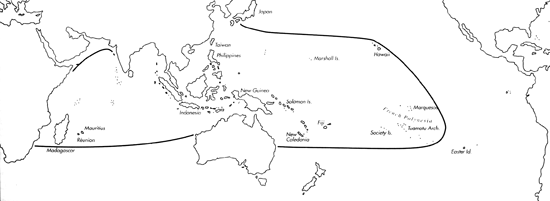
Skip Navigation Links
View access keys for this site.

Range: Entire Indo-Pacific, except for Red Sea.
Description: Moderately small to moderately large, moderately solid to solid. Last whorl conical to ventricosely conical; outline convex below shoulder, straight below. In larger specimens, columella often curved to left near base. Shoulder angulate to subangulate. Spire of moderate height, outline domed. Larval shell projecting, of 3.25-4 whorls; maximum diameter 0.9-1.05 mm. First 0.5-2 postnuclear whorls tuberculate. Teleoconch sutural ramps flat to slightly concave, with 2-3 increasing to 4-5 spiral grooves; number of grooves may be smaller and grooves are often obsolete on latest ramps. Last whorl smooth except for a few weak spiral ribs at base, or with raised, widely spaced spiral ribs from base to shoulder; wide grooves between ribs, with numerous heavy axial striae occasionally crossing 1-3 spiral threads. Smooth and heavily sculptured specimens occur in the same populations.
| Shell Morphometry | ||
|---|---|---|
| L | 28-69 mm | |
| RW | 0.13-0.37 g/mm | |
| (L 28-58 mm) | ||
| RD | 0.53-0.64 | |
| PMD | 0.75-0.89 | |
| RSH | 0.09-0.19 | |
Juvenile shells (L less than 10 mm) uniformly lemon yellow, becoming overlaid with red and white colour zones during growth (Pl. 51, Fig. 6). In adults, ground colour varying from white to rose. Last whorl with orange-red to pink or tan clouds fusing into 2 variably broad spiral bands, on each side of centre. Adapical and central ground-colour bands crossed by axial clouds. Fine dotted and dashed brown spiral lines may extend from base to shoulder but are very variable in number and arrangement. Basal part of columella, siphonal fasciole and siphonal notch pink to violet. Larval whorls and a variable number of early postnuclear sutural ramps yellow; following ramps with clouds and blotches of same colour as last whorl. Aperture pale pink to violet.
Periostracum almost colourless to olive grey, thin, and translucent to almost opaque, with spiral rows of long tufts on last whorl and tufted margins in sutural ramps in Philippine specimens; variation in colour and thickness not dependent on size. A similar periostracum occurs in Hawaii (Kohn & Weaver, 1962) and Marshall Is.
In Hawaii and Marshall Is., animal white to pale yellow, densely mottled and suffused with greyish yellow, variably speckled with dark grey to black. Dorsum of foot more yellow at both ends; black spots denser marginally and fewer but larger at posterior end. Siphon with dense black spotting on anterior two-thirds; black spots fusing into blotches at base (Kohn & Weaver, 1962; Pearson, unpubl. observ.). At Hansa Bay, dorsum of foot with a spotted black pre-marginal band, the latter crescent-shaped anteriorly and separating a yellow marginal zone from a paler median zone; anterior part pale tan. Sole of foot dull white. Rostrum yellow. Tentacles white. Siphon cream, suffused with pink and dotted with dark brown, lighter ventrally (Pl. 76, Fig. 59; Chaberman, pers. comm., 1981).
Radular teeth with an adapical barb opposite a blade; strong serration to the centre of the shaft, ending in a blunt cusp; base with a spur (Rol├Īn, unpubl. observ.).
Habitat and Habits: In 5-120 m. In Hawaii, in 18-90 m (Kohn, 1959a; Kohn & Weaver, 1962; Kay, 1979). In Fiji, subtidally under coral heads (Cernohorsky, 1964). In Marshall Is., in caves and coral rubble in 10-18 m. In New Caledonia, in white sand beneath coral boulders in 5-40 m (Tirard, pers. comm., 1989). In E. New Britain, subadults in 15-25 m among live coral but not in sand (Richards, pers. comm., 1989). At Hansa Bay, on coral rubble. In southern Natal, in 30 m and deeper (Liltved & Millard, 1989). In Hawaii, C. pertusus feeds on polychaetes (Kohn, 1959b). Egg diameter of 132 ┬Ąm predicts a minimum pelagic period of 29 days (Hawaii, Perron, 1981 b; Perron & Kohn, 1985).
Discussion: Despite its conchological variation, C. pertusus cannot be confused with any of its Indo-Pacific congeners, although juvenile specimens resemble C. corallinus. The larval and early teleoconch whorls of the latter species are pink, not yellow, the animal is pink to red, not greyish yellow with black spots. C. festivus refers to the typical, smooth form of C. pertusus, and C. amabilis to a heavily sculptured form.

C. pertusus range map
This section contains verbatim reproductions of the accounts of 316 species of Conus from the Indo-Pacific region, from Manual of the Living Conidae, by R÷ckel, Korn and Kohn (1995). They are reproduced with the kind permission of the present publisher, Conchbooks.
All plates and figures referred to in the text are also in R÷ckel, Korn & Kohn, 1995. Manual of the Living Conidae Vol. 1: Indo-Pacific Region.
The range maps have been modified so that each species account has it own map, rather than one map that showed the ranges of several species in the original work. This was necessary because each species account is on a separate page on the website and not confined to the order of accounts in the book.
Return to framed version (returns to search page)